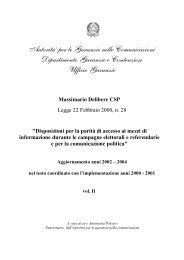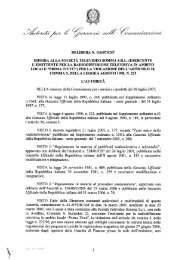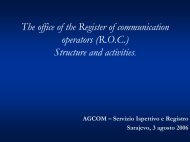- Page 1 and 2: Communications Regulatory Authority
- Page 3 and 4: 1. THE COMMUNICATIONS SYSTEM IN THE
- Page 5 and 6: But the fixed-mobile convergence is
- Page 7 and 8: generation networks also make possi
- Page 9 and 10: not only from the companies mention
- Page 11 and 12: Figure 1.2. World telecommunication
- Page 13 and 14: Figure 1.4. Hot spots in the world
- Page 15 and 16: nine regions where it has concentra
- Page 17 and 18: video channels, over 600 video-on-d
- Page 19: Also with reference to the offering
- Page 23 and 24: The supply of these services has al
- Page 25 and 26: offered. In particular, an increasi
- Page 27 and 28: Nelonen, Nokia, TeliaSonera, and YL
- Page 29 and 30: • the purchase of Meteor, an Iris
- Page 31 and 32: confirmed as the leading country in
- Page 33 and 34: 1.1.2. Audiovisuals The world telev
- Page 35 and 36: On the other hand, satellite operat
- Page 37 and 38: The structure of the national telev
- Page 39 and 40: having the availability, on an excl
- Page 41 and 42: Figure 1.16. Western Europe: breakd
- Page 43 and 44: It is interesting to note that the
- Page 45 and 46: undergo further acceleration in 200
- Page 47 and 48: 1.2. ITALY 1.2.1. Telecommunication
- Page 49 and 50: Figure 2.4. Trend of consumer price
- Page 51 and 52: The shift of traffic to mobile serv
- Page 53 and 54: is a significant part of the consum
- Page 55 and 56: Secondly, there has been an increas
- Page 57 and 58: - “Smart” services characterise
- Page 59 and 60: The growth did not live up to expec
- Page 61 and 62: AGCOM’s regulatory intervention c
- Page 63 and 64: Table 1.5. Market shares in mobile
- Page 65 and 66: TV services might become the next k
- Page 67 and 68: connections in the Italian market a
- Page 69 and 70: mobility), as an alternative to oth
- Page 71 and 72:
DFREE Rete 4 Italia 1 Sport Italia
- Page 73 and 74:
Table 1.9. Resources breakdown of t
- Page 75 and 76:
In 2005, RTI holds a market share o
- Page 77 and 78:
Table 1.13. Audience of main nation
- Page 79 and 80:
Until now, such investments have be
- Page 81 and 82:
From the viewpoint of the economic
- Page 83 and 84:
The readers of this product are mos
- Page 85 and 86:
Table 1.20. Monti Group (Poligrafic
- Page 87 and 88:
TABLE 1 DAILY NEWSPAPERS: NATIONWID
- Page 89 and 90:
Il Centro Campanile Nuovo a r.l. Fi
- Page 91 and 92:
La Gazzetta di Taranto Società P.a
- Page 93 and 94:
Piccola s.c.r.l. Ore 12 Centro Stam
- Page 95 and 96:
L'avvisatore Marittimo L'avvisatore
- Page 97 and 98:
Messaggero del Lunedì Editoriale F
- Page 99 and 100:
Leggo Sigma Editoriale s.p.a. 154,1
- Page 101 and 102:
La Gazzetta di Lecce Società P.a.
- Page 103 and 104:
Table 1.23. Advertising investments
- Page 105 and 106:
eached 3%. Television stands out as
- Page 107 and 108:
Table 1.30. Percentage breakdown of
- Page 109 and 110:
Table 1.33. Percentage breakdown of
- Page 111 and 112:
Surcharged services By decree of th
- Page 113 and 114:
2. ACTIONS UNDERTAKEN BY AGCOM 113
- Page 115 and 116:
electronic communications networks
- Page 117 and 118:
an 1PC-4.75% reduction restriction
- Page 119 and 120:
Markets for fixed calls over the pu
- Page 121 and 122:
AGCOM confirmed the position set fo
- Page 123 and 124:
eference offers relating to the 200
- Page 125 and 126:
With this measure AGCOM has then re
- Page 127 and 128:
data for the purpose of assembling
- Page 129 and 130:
termination on single mobile networ
- Page 131 and 132:
when foreign mobile operators’ us
- Page 133 and 134:
analyzing any possible regulatory o
- Page 135 and 136:
calculation, with regard to 2003 an
- Page 137 and 138:
The same supervisory action was car
- Page 139 and 140:
price-cap system on these services,
- Page 141 and 142:
Fixed-to-mobile (retention) -19.2 -
- Page 143 and 144:
up in cutting rates at that time, a
- Page 145 and 146:
according to the termination operat
- Page 147 and 148:
Rate ceiling supplement for the pro
- Page 149 and 150:
handset use restrictions when the S
- Page 151 and 152:
Mobile television services In 2005,
- Page 153 and 154:
undertakings with a significant mar
- Page 155 and 156:
Resolution no. 11/06/CIR allows VoI
- Page 157 and 158:
message advertising of the rate cha
- Page 159 and 160:
TELECOM ITALIA/VODAFONE Pending INF
- Page 161 and 162:
order areas and entering into the r
- Page 163 and 164:
After describing digital terrestria
- Page 165 and 166:
The first activity implemented by t
- Page 167 and 168:
and rights, and of a person’s dig
- Page 169 and 170:
Provisions relating to dominant pos
- Page 171 and 172:
In order to make the above-mentione
- Page 173 and 174:
In this context, AGCOM issued 7 ord
- Page 175 and 176:
subscribers without necessarily imp
- Page 177 and 178:
In this connection it should be hig
- Page 179 and 180:
LA7 TELEVISIONI s.p.a. La7 terr. 55
- Page 181 and 182:
March 2000, which regulates the iss
- Page 183 and 184:
technical restrictions for the need
- Page 185 and 186:
Misleading advertising Under articl
- Page 187 and 188:
AGCOM also explained that the absol
- Page 189 and 190:
The third area relating to children
- Page 191 and 192:
- 5 were due to the breach of artic
- Page 193 and 194:
Publishing Sound and/or television
- Page 195 and 196:
2.11. RELATIONS WITH CONSUMERS AND
- Page 197 and 198:
AGCOM enacted regulations for the s
- Page 199 and 200:
Activation of unwanted services 1,0
- Page 201 and 202:
WIND CPS 173 WIND Unwanted tariff p
- Page 203 and 204:
As a matter of fact, the high numbe
- Page 205 and 206:
stage hearings resulted in 43 petit
- Page 207 and 208:
virtue of the provisions under arti
- Page 209 and 210:
With Resolution no. 417/04/CONS set
- Page 211 and 212:
In the timeframe between 1 May 2005
- Page 213 and 214:
In 2 of the latter cases the insert
- Page 215 and 216:
3. AGCOM’S INSTITUTIONAL RELATION
- Page 217 and 218:
First of all, the year 2005 registe
- Page 219 and 220:
ears witness to the appreciation of
- Page 221 and 222:
Audiovisuals As for the audiovisual
- Page 223 and 224:
audiovisual and telecommunications
- Page 225 and 226:
Administrations, diplomatic represe
- Page 227 and 228:
Around 60 inspection union document
- Page 229 and 230:
systems C/7069 Acquisition of a cor
- Page 231 and 232:
adio broadcasting system s.c.r.l. C
- Page 233 and 234:
is even more appropriate in the cur
- Page 235 and 236:
The delegation concerning the prote
- Page 237 and 238:
Table 3.3. Implementation of the de
- Page 239 and 240:
with the associations of reference
- Page 241 and 242:
During 2005, the Special Unit also
- Page 243 and 244:
4. Governance structure 243
- Page 245 and 246:
Figure 4.1 4.1. AGCOM’s governing
- Page 247 and 248:
President’s Cabinet Guido Stazi D
- Page 249 and 250:
with the institutional actions to s
- Page 251 and 252:
achievement of the objectives set b
- Page 253 and 254:
for conflict of interests), € 22,
- Page 255 and 256:
in the economic, legal, sociologica
- Page 257 and 258:
Measures to guarantee rights of end
- Page 259 and 260:
DECT .............Digital Enhanced
- Page 261 and 262:
MVAS .............Mobile Value Adde















